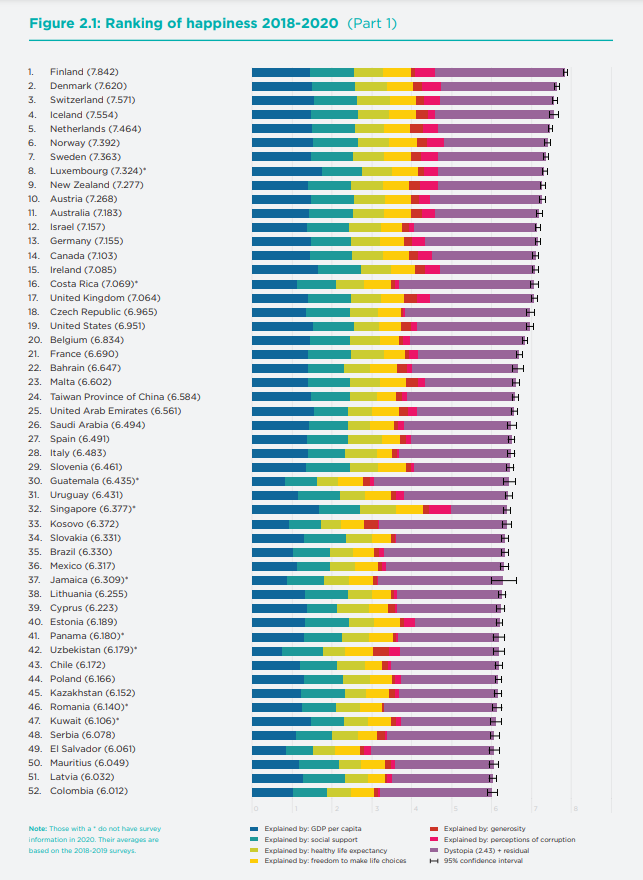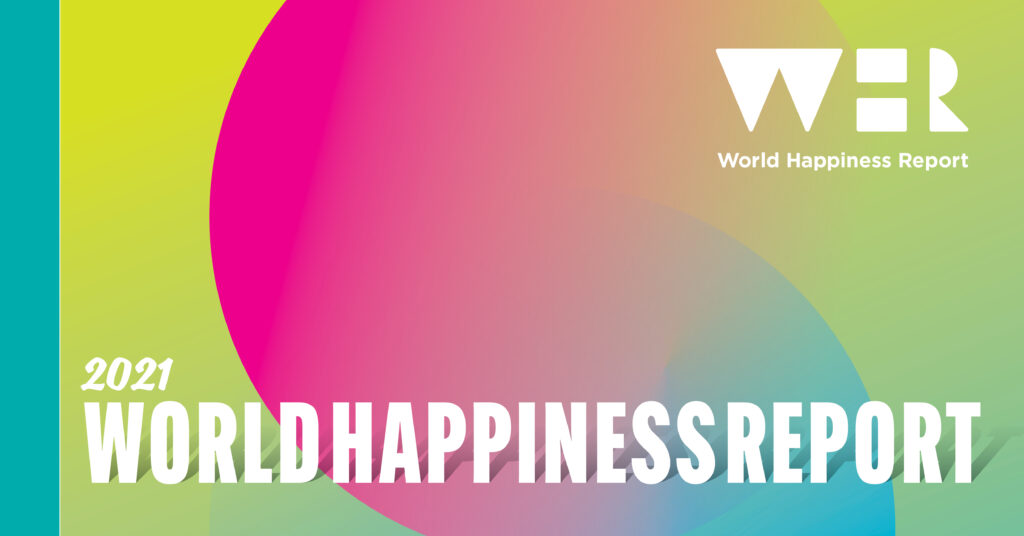Released on the International Day of Happiness (March 20th), the annual World Happiness Report offers an updated snapshot of the state of happiness across the globe. What was the theme of the 2021 report? Well, you probably already guessed it . . .
The 2021 report marks the ninth edition of the World Happiness Report (WHR) and, much like everything else from 2020, this year’s collection of research was set amidst a backdrop with COVID-19 clearly in focus. Each of the Report’s eight chapters narrows in on specific ramifications of the COVID-19 pandemic, considering and measuring the ways in which people across the world may have fared better or worse.
COVID-19 has shaken, taken, and reshaped lives everywhere.
World Happiness Report 2021, p. 15
In focusing on the effects of the pandemic, the authors’ aim was two-fold: first, to evaluate how the lives of individuals were impacted (giving more attention to daily emotions than had been given in previous WHRs), and also to consider how governments have dealt with and managed (or failed to manage) COVID-19.
Happiness: a Casualty of the Pandemic?
Throughout the document, you’ll find the gravity of the pandemic repeated in the form of death tolls—as it notes how COVID-19 accounted for 2 million deaths in 2020, a rise in annual deaths of nearly 4%. Naturally, this death toll is impacting national life expectancies. In the United States, where the death rate was particularly high, one calculation estimates that the national life expectancy had fallen by one year (Andrasfay, T., & Goldman, N., 2021, as cited on p. 194).
Inextricably linked with the pandemic, of course, is an ever-growing mental health crisis. Many already recognize that the threat to mental health is the underlying crisis within the COVID-19 pandemic. Mental well-being has been one of the pandemic’s casualties. Mental healthcare needs have increased at the same time as mental health services have been disrupted. Significant proportions of populations around the globe experienced persistently and significantly lower mental wellness compared with pre-pandemic experiences. As the WHR states, the mental health effects of the COVID-19 pandemic were “large, negative, and remarkably consistent across the data and studies” (p. 124).
In the United States, for instance, one study compared surveys of self-reported happiness and life satisfaction from January 2020 with the same surveys in June 2020 and found significant declines in satisfaction as well as in domains of flourishing (e.g., financial stability, mental and physical health, meaning and life purpose, social relationships) (citing VanderWeele et al, 2020, p. 133). In May 2020, within the same window of the U.S. study, general measures of mental health in the United Kingdom were 7.7% lower than predicted, while mental health problems were up 47% (p. 10).
While the rise in mental health challenges can be alarming, it’s interesting to note that most studies indicate that the pandemic’s impact to date has largely been affective—impacting moods and daily emotions more so than overall life satisfaction. The WHR 2021 identified four main mechanisms by which different stressors of the pandemic might affect mental health, including health-related anxieties; worries about one’s financial situation; home and family arrangements; and restrictions of fulfilling activities.
Life, Restricted
At the start of the pandemic, and again with subsequent waves, many governments instituted non-pharmaceutical interventions (NPIs), such as lockdowns and/or restrictions on indoor dining and gathering, as part of efforts to control the spread. I could have easily assumed a connection between such policies and a decline in happiness; however, in some senses, I would have been wrong.
People’s social connections are vital to their happiness, so with physical distancing policies (poorly called “social distancing”) feelings of connectedness dropped as a sense of loneliness increased and happiness levels fell. However, such interventions were necessary to control the spread of the disease. Seemingly, many people recognized this, which influenced their overall sentiments.
In fact, in China, it was found that the lower levels of happiness that resulted from rising numbers of daily cases were offset considerably when the government instituted strict policies to control the spread. At the average level of strictness, COVID-19 restrictions could offset about 60% of the negative effect of daily new confirmed cases on expressed happiness (page. 81). So strict measures actually mediated negative emotions associated with other aspects of the pandemic.
“Yeah, but what about national prosperity and growth?” Well…
Although typical arguments against strict interventions claim that such restrictions will destroy the economy, one study found that effective COVID-19 strategies were indeed not tied to economic trouble. The countries that chose to control the pandemic showed no trade-off between a healthy economy and a healthy population. The most effective strategy for controlling COVID-19 was to drive community transmission to zero; the nations that achieved this “saved lives and achieved more open societies and economies at the end of 2020” (p. 51).
Combatting COVID, Who Fared Best?
Considering how some people seemed to demonstrate a bit more mental health resilience than others in the face of the pandemic, Chapter 6 of WHR 2021 identified protective factors and risk factors for positive and negative well-being. Protective factors were positive life features, including gratitude, grit, prior social connections, volunteering, exercise, having a pet, and experiencing activities that provide flow. On the other hand, negative life features included loneliness, more time spent consulting news, financial instability, a sense of uncertainty, a lack of proper digital connections (which served as a good stand-in for social interactions during periods of lockdown), and prior mental illness.
Not surprisingly, mental health declines were higher among those with pre-existing mental health problems as well as among populations who are generally more susceptible to mental health challenges—thus, the pandemic has only worsened existing inequalities in mental well-being. It’s important to note that most surveys, including those used for the WHR, are unable to capture the experiences of some of the hardest-hitting groups (e.g., those living in elder-care, prison facilities, hospitals, refugee camps, or on the streets).
And for everyone impacted, it must be noted that the long-run consequences of the pandemic on mental health remains uncertain.
Factors of Intervention Success
At the national level, certain factors seemed to either support or threaten the success of pandemic response strategies. For both mental and physical health, national interventions played an important role. As we can see above, the dual ability of such interventions to control disease and offset negative feelings was significant and measurable. The most successful interventions included measures that were both top-down and bottom-up. The success of COVID-19 strategies was further influenced by:
- Confidence in public institutions
- Income (in)equality
- Lessons learned from past pandemics (e.g., SARS)
- Whether the head of government was a woman
However, a few things were found to inhibit the success of national interventions.
First, NPIs were less effective in more individualistic cultures where assertions of “personal liberty” seemed to be barriers to the adoption of or adherence to such policies. COVID-19 strategies were further inhibited by a lack of scientific knowledge and the general public’s “lack of understanding of the epidemiology of the pandemic and susceptibility to false information and fake news” (p. 8).
The Overall Rankings
Perhaps the most sensational component of the WHR each year is the annual ranking of the world’s happiest countries. Finland again topped the list, with no change in rank among the following three—Denmark (2nd), Switzerland (3rd), and Iceland (4th). Making its way into the top 5, the Netherlands pushed Norway out and into the number 6 spot.

The WHR 2021 found that the same six factors previously recognized as central to supporting well-being (income, health, someone to count on, freedom, generosity, and trust) continued to influence happiness during the pandemic in almost exactly the same way as in previous years (p. 50). Trust was as important as ever and particularly important when considering COVID-19 strategies, which “…required the whole structure of private and public lives to be refocused on fighting the pandemic” (p. 51). Societies with higher trust and greater income equality were more successful at fighting COVID-19.
Conclusion
COVID-19 lead to a substantial rise in symptoms of mental ill-health at the same time as mental health services were disrupted. Rather than focusing on happiness, generally, the Report read a bit more like an argument for appropriate pandemic policies and the connection of such a response to well-being.
Ever-the-optimist, I’d be remiss to not mention two key silver linings observed in the research. First, although people aren’t traveling, they’re rediscovering their neighborhoods. This, along with new forms of connecting with loved ones, demonstrates a chance for people to cultivate stronger social and place-based connections! And furthermore, I’ll echo one final sentiment from the WHR 2021: “On the positive side, the pandemic has shone a light on mental health as never before. This increased public awareness bodes well for future research and better services that are so urgently needed.” (p. 10)
As more people become aware of the challenges of addressing mental health, new doors are opened to have conversations about the issue, and take action to bring mental wellness to everyone everywhere.

